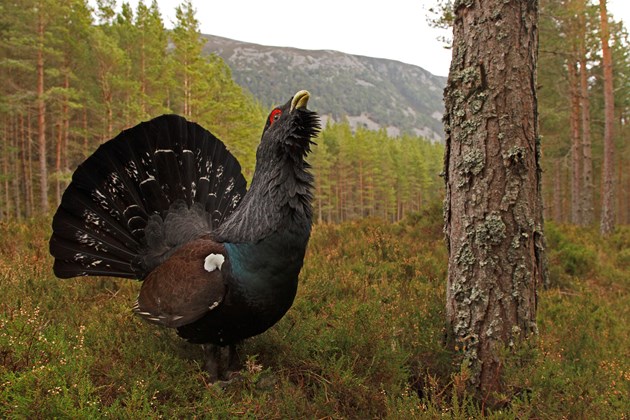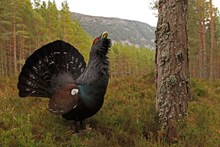25 February, 2022
Measures to save capercaillie outlined

A new scientific review has advised on measures which could help reverse the fortunes of the iconic capercaillie in Scotland.
The report from a sub-group of the NatureScot Scientific Advisory Committee (SAC) advises that if perilous population declines continue the species could be lost to Scotland within two to three decades.
After a thorough review of the scientific evidence, the report advises that current breeding success appears to be too low to allow recovery of the population.
Interventions that improve the survival of eggs and young chicks are especially important. These include predator control and diversional feeding; and creation of refuges around hotspots to minimise disturbance. Survival of adults would be enhanced with more work to mark or remove deer fences, which can cause injury or death to birds in flight.
The review drew on a large amount of impressive past and on-going research by members of the Scottish Capercaillie Group.
Factors having the biggest impact on breeding success were identified as increased predation from foxes, pine martens and crows; as well as more disturbance due to rises in visitor numbers and recreational activities. The report highlighted the importance of further action across the core area of Badenoch and Strathspey if the population is to be conserved.
Drawing on the report, areas for further action being considered include:
- Carefully designed and monitored diversionary feeding of predators, currently being investigated, being expanded to provide alternative food during the breeding seaso
- Additional predator control to remove crows, foxes and including pine martens. In the case of pine marten this would be non-lethal, through trap and release as part of reintroduction to other parts of the UK.
- Seasonal visitor management to create larger refuges from human disturbance in collaboration with communities.
- Extend deer fence marking and removal.
NatureScot and the Cairngorms National Park Authority are considering the report in detail and working with partners will draw up options for improving the prospects for capercaillie. This will be carefully considered to align with the wider plans for ecological restorations in the Cairngorms to address the biodiversity and climate crisis. Further work is needed to fully cost the proposals and to ensure that money is invested where it will have greatest impact.
Professor Neil Metcalfe, SAC sub-group chair, said: “We were immensely impressed with the depth and range of work undertaken on capercaillie by members of the Scottish Capercaillie Group. We hope our report contributes to further action to boost numbers of this special bird.”
Biodiversity Minister Lorna Slater said: “Capercaillie are magnificent birds and an iconic species for Scotland, so I am deeply concerned that their population continues to decline. This underlines the need to redouble our efforts to work in partnership and at the landscape scale to reverse these declines.
“We will carefully consider the recommendations in this report and work with partners to build on the positive conservation work already happening on the ground, such as through the Cairngorms Capercaillie Project.”
Eileen Stuart, NatureScot Deputy Director of Nature and Climate Change, said: “It’s clear that the future of capercaillie in Scotland is extremely vulnerable. This excellent report sets out the scientific evidence on capercaillie conservation and management, and the steps that are now needed to help save this key species.
“We recognise the urgency of the situation and this report will be crucial as we look at options to accelerate action on the ground. Important work is already underway, and so there is much to build on.
“Drawing on the innovative work of the pioneering Cairngorms Capercaillie Project, funded by the National Lottery Heritage Fund, it is essential that our next steps are developed in close consultation with local communities, landowners and partners and in line with the Scottish Outdoor Access Code. We’ll be working closely with all interested parties in the months ahead as we look to secure a future in Scotland for this iconic bird.”
Grant Moir, Chief Executive of the Cairngorms National Park Authority, said: “Capercaillie are an iconic species in the Cairngorms National Park and we have been working hard with partners through the Cairngorms Capercaillie Project to help ensure their long term survival.
“We welcome the report from the Science Advisory Committee Sub-Group as this gives us the best evidence for ensuring we tackle the key issues, such as disturbance and predation. We need to consider the report fully, discuss with partners how best to take forward its advice and move quickly to take action on the ground.”
ENDS
Contact information
- Name
- NatureScot Media
- Telephone
- 0131 316 2655
- media@nature.scot
Notes to editors
Read the full report here: https://www.nature.scot/doc/review-capercaillie-conservation-and-management-report-scientific-advisory-committee
NatureScot’s Scientific Advisory Committee (SAC) is made up of external specialists, providing advice and expertise to NatureScot. The role of the SAC is to advise the NatureScot Board and staff on scientific and technical matters; reviews the quality of NatureScot research; advise on the scientific basis for the notification of any Site of Special Scientific Interest (SSSI) in Scotland and contribute specialist knowledge and wider advice via working groups and individually.
The Cairngorms Capercaillie Project, funded by the National Lottery Heritage Fund and led by the Cairngorms National Park Authority, is the coming together of a wider range of people in the Cairngorms National Park to help secure the long-term survival of capercaillie in the UK.
The Scottish Capercaillie Group is formed of conservation and land management government bodies, NGOs and experts committed to researching and conserving capercaillie in Scotland.
NatureScot is Scotland's nature agency. We work to enhance our natural environment in Scotland and inspire everyone to care more about it. Our priority is a nature-rich future for Scotland and an effective response to the climate emergency. For more information, visit our website at www.nature.scot or follow us on X at https://x.com/NatureScot
’S e NatureScot buidheann nàdair na h-Alba. Bidh sinn a’ neartachadh àrainneachd na h-Alba agus a’ brosnachadh dhaoine gu barrachd suim a chur ann an nàdar. Tha e mar phrìomhachas againn gum bi nàdar na h-Alba beairteach agus gun dèilig sinn gu h-èifeachdach le èiginn na gnàth-shìde. Tha an tuilleadh fiosrachaidh aig www.nature.scot no air X aig https://x.com/NatureScot

